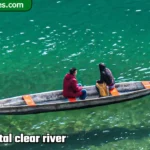People care more about the world, thus we move differently. Now, the draw of distant places and stunning scenery comes with a responsibility: travel sustainably. Ecotourism, or sustainable travel, is a terrific way to see the world while benefiting locals and the environment. This page details environmentally friendly travel. It shows you how to reduce your carbon impact and travel greener.

Contents
- 1 How to Figure Out Your Carbon Footprint
- 2 Picking Green Transportation
- 3 Eco-Friendly Places to Stay
- 4 Packing and using things in a responsible way
- 5 Helping the communities around us
- 6 Using less single-use plastics
- 7 Taking part in green activities
- 8 Participating in efforts to save the environment
- 9 How to Make Up for Your Carbon Emissions
- 10 How to Plan Ethical Encounters with Wildlife
- 11 Getting your own and others’ education
- 12 Conclusion
How to Figure Out Your Carbon Footprint
Every move we make, every travel we make, and every place we stay increases our carbon footprint. To travel in an environmentally friendly manner, awareness is the first step. Consider how your vacation will impact the environment before you leave on it. Every decision, from where to stay to how to get around, counts.
Carbon dioxide (CO2) is the primary warming gas that is used to calculate carbon footprints. Flying is one of the most carbon-intensive modes of transportation, and the transportation sector as a whole is a significant producer of this emissions. Even though travel can enrich our lives and teach us new things, it’s crucial to be conscious of the harm it might cause to the environment.
Picking Green Transportation
The journey can be just as significant as the destination when it comes to environmentally friendly travel. When traveling, opt for greener modes of transportation including trains, buses, and bicycles, which emit significantly less carbon than automobiles and aircraft. If you must travel by air, consider nonstop routes and seats in economy class as these emit the least carbon dioxide.
Additionally, “slow travel” is gaining popularity. Instead of rushing from one location to the next, slow travel involves spending more time at fewer locations. This not only lessens your carbon footprint but also enables you to study more and get to know a culture better.

Eco-Friendly Places to Stay
One of the most important aspects of healthy travel is the accommodation you pick. Green resources and energy-saving measures are becoming increasingly common in the hospitality industry. Look for motels, inns, and guesthouses that share your commitment to environmental sustainability and your desire to minimize your trip’s carbon footprint.
If you’re looking for a place to stay, make sure it has environmental certifications like LEED (Leadership in Energy and Environmental Design) or Green Key. These demonstrate that the establishment is ecologically responsible. In addition to encouraging environmentally conscious enterprises to continue their good work, your patronage will send a message to the travel industry that eco-friendly services are in high demand.
Packing and using things in a responsible way
Packing lightly will reduce the amount of luggage you have to carry and the amount of fuel your vehicle or aircraft needs to carry. Remember to pack reusable items like water bottles, tools, and shopping bags when you’re packing. These few adjustments can have a major impact on reducing plastic waste.
Reduced plastic waste is a problem everywhere, but traveling is where it’s most crucial. Too much plastic use has negative impacts all across the world, including contaminated oceans and overflowing landfills. You can lessen plastic trash both at home and globally by making wise decisions.
Helping the communities around us
Sustainable travel also benefits the local economy and community in addition to the environment. When you travel, stay in local-owned accommodations, eat at local eateries, and purchase souvenirs from regional craftspeople. Your purchases may have a positive impact on the local economy and contribute to its expansion.
Community-based tourism is a fantastic opportunity to both directly benefit locals and see their culture firsthand. Participate in classes, interact with local guides, and see how locals go about living their daily lives. This benefits the local economy and encourages cultural understanding and sensitivity among the populace.
Using less single-use plastics
The issue of single-use plastics, which are ubiquitous, has taken center stage in the environmental debate. It’s crucial to use disposable plastics as little as possible when traveling responsibly. Bring a refillable water bottle, and consider getting a set of snack and leftover storage containers that you may use over and over. By doing this, you’ll contribute to reducing the demand for single-use plastics, which frequently contaminate our landscapes and wind up in our oceans.
The tourism industry has made a lot more efforts in recent years to reduce the usage of single-use plastics. Plastic straws are increasingly being replaced with bulk dispensers for toiletries and drink refill stations in hotels and airplanes. These actions, when combined with what individuals do on their own, significantly reduce the quantity of plastic waste that travelers leave behind.
Taking part in green activities
Engage in sustainable travel by taking actions that respect and help to safeguard the environment. When you go hiking on pristine trails, dive in a marine preserve, or see wildlife in its natural habitat, always remember to leave no trace. By following these guidelines, you can avoid damaging the delicate ecosystems you are currently exploring.
Adventure travel and ecotourism frequently go together. Kayaking, rock climbing, and hiking are examples of activities that allow you to appreciate nature’s beauty and instill a strong concern for the environment. Responsible tour operators prioritize things like safety, the environment, and cultural sensitivity at the top of their priorities list. Tourists and the locations they visit will both benefit from this general improvement.
Participating in efforts to save the environment
You could contribute to environmental protection while you’re on vacation if you want to do something different from what most visitors do. You can volunteer in numerous locations to assist with initiatives including beach cleanups, tree plantings, and animal protection. Making improvements to the locations you visit will provide a positive impression that will endure.
Volunteering and participating in conservation efforts benefit the environment where you are while also giving travelers a sense of direction and a sense of community. These experiences create lifelong memories and frequently improve your comprehension of the issues that the folks you’re aiding confront.
How to Make Up for Your Carbon Emissions
Even though it is difficult to eliminate all carbon emissions from travel, you can take actions to mitigate your influence. Many organizations have carbon offset programs that invest in things like planting and clean energy to compensate for the pollution caused by travel. Calculating and offsetting your carbon footprint is a concrete action you can take to reduce the environmental impact of your trips.
Carbon offset programs function by calculating how much carbon dioxide you emit into the atmosphere when you travel and sponsoring projects that remove the same amount of carbon dioxide. These projects could involve planting trees, restoring wetland regions, or investing in green energy sources. Carbon offsetting isn’t a perfect solution, but it can help offset some of the environmental damage caused by your travel.
How to Plan Ethical Encounters with Wildlife
The most important thing for people who wish to encounter animals is to make responsible choices. Don’t go to venues where animals are used for entertainment. Choose ethical wildlife adventures that prioritize the animals’ well-being and conservation. Giving money to wildlife sanctuaries and seeing animals in their natural settings can help keep biodiversity alive.
Wildlife tourism is a challenging issue because many attractions that bring visitors in close contact with animals frequently have underlying ethical concerns. Riding elephants, photographing tigers, and swimming with dolphins may appear entertaining, but they also cause animals to suffer and harm their ecosystems. By choosing ethical options, you demonstrate that the only acceptable methods to interact with wildlife are those that are responsible and compassionate.
Getting your own and others’ education
Learning how to move in an environmentally friendly manner is an ongoing effort. Learn everything you can about the locations you visit, including their cultures and natural problems. Share your knowledge and experiences with other tourists to urge them to perform environmentally friendly things. By spreading the word, you become a part of a global movement that values both exploration and environmental stewardship.
Educational resources, movies, and travel blogs can teach you a lot about the areas you desire to explore. Learning about a location’s history, culture, and local customs enhances your vacation and allows you to make responsible tourist decisions.
Conclusion
Ecotourism is not merely the latest trend; it represents a fundamental shift in perspective. We can pave the way to responsible and rewarding travel by considering the impact of our decisions on the world around us, making informed choices, and lending our support to environmentally conscious initiatives. As conscientious explorers, we may shape the way future generations see the world and instill in them a lifelong commitment to protecting the place we all call home. If we all pitch in, the world’s wonders won’t be lost to the next generation.









